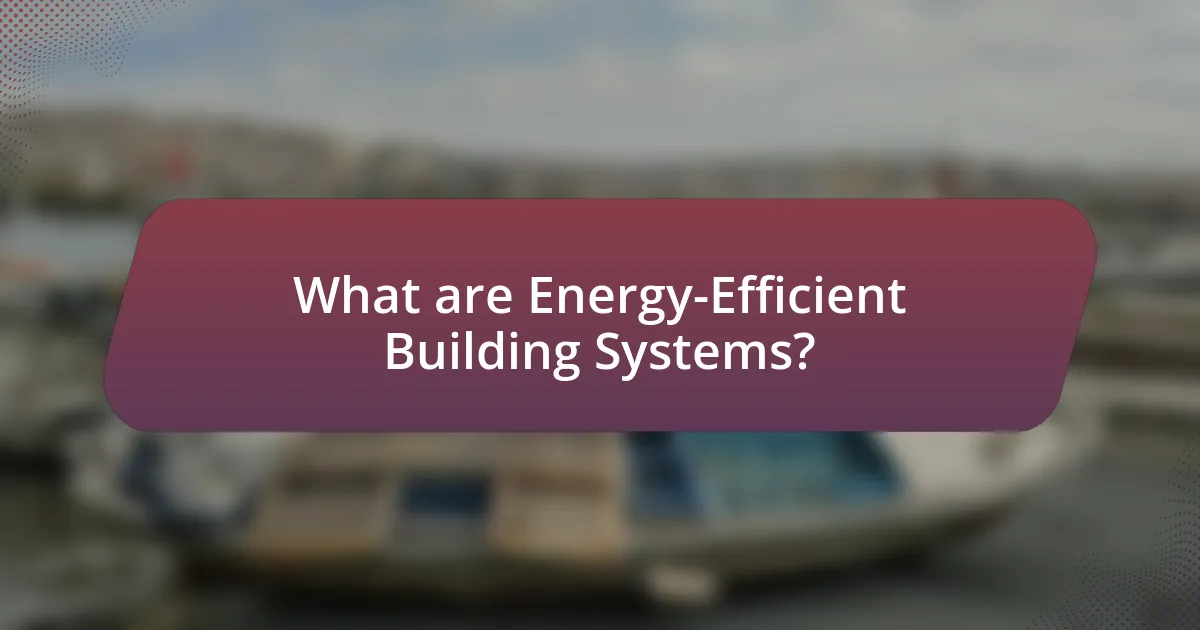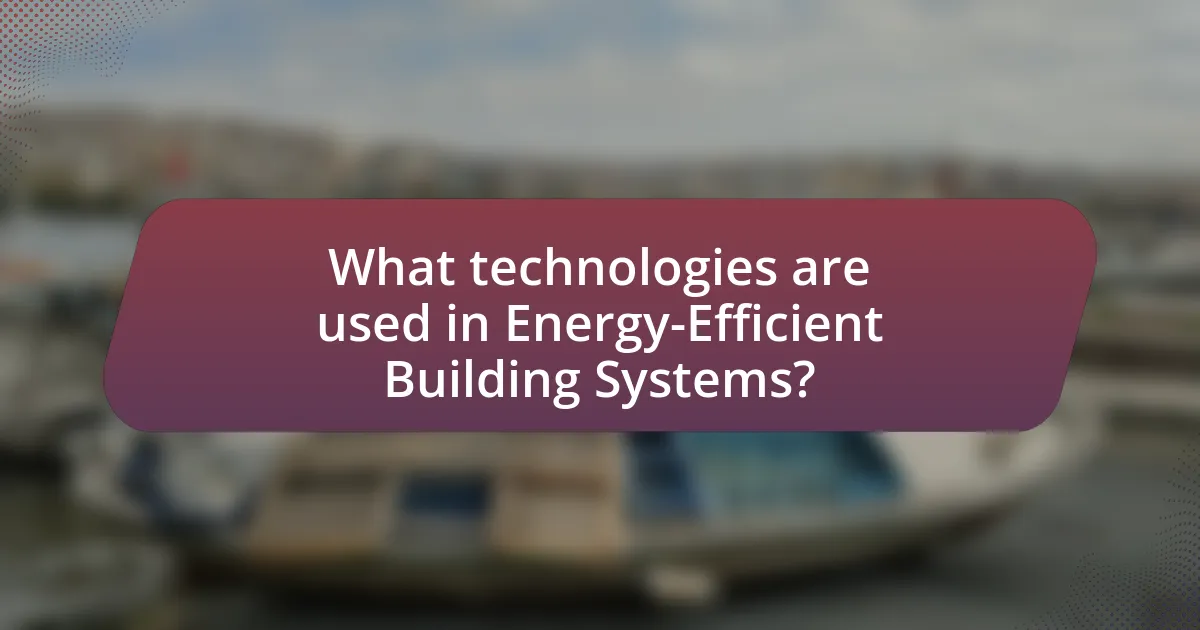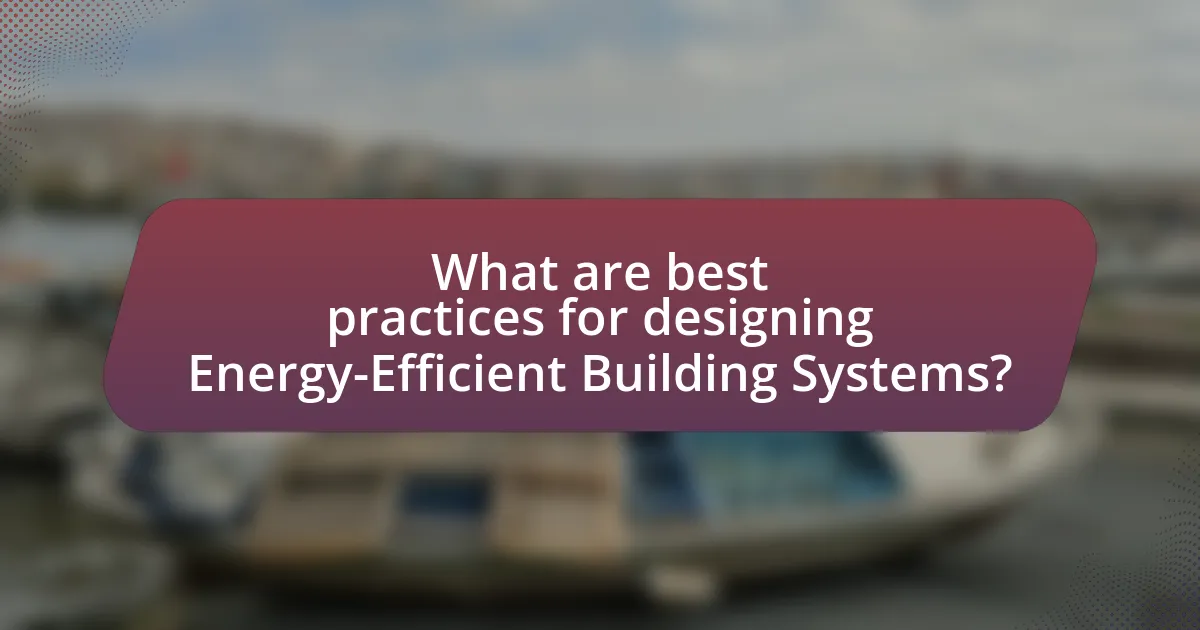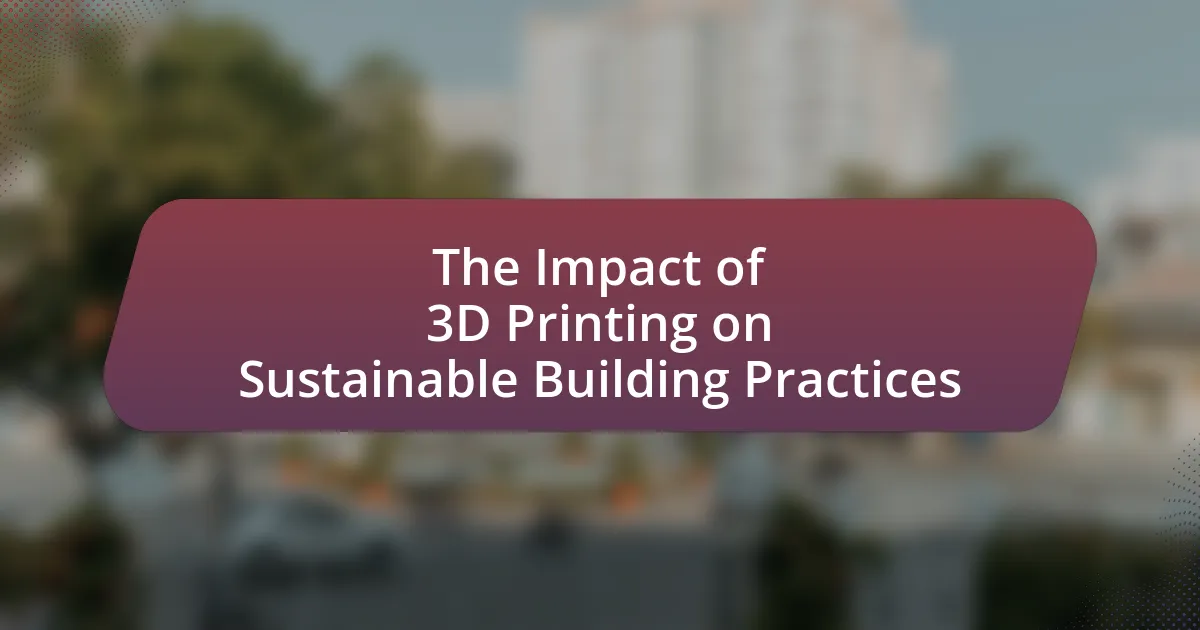Energy-efficient building systems are integrated technologies and practices aimed at reducing energy consumption in buildings while ensuring comfort and functionality. This article provides a comprehensive overview of these systems, detailing their contributions to sustainability, key principles, and various types, including passive design strategies and active systems. It also examines the benefits of implementing energy-efficient systems, such as reduced operational costs and environmental impact, and discusses the technologies involved, including renewable energy sources and smart technologies. Additionally, the article addresses challenges in retrofitting existing buildings and offers best practices for designing energy-efficient systems, emphasizing the importance of collaboration between architects and builders.

What are Energy-Efficient Building Systems?
Energy-efficient building systems are integrated technologies and practices designed to reduce energy consumption in buildings while maintaining comfort and functionality. These systems include advanced insulation, energy-efficient HVAC (heating, ventilation, and air conditioning) systems, energy-efficient lighting, and renewable energy sources such as solar panels. According to the U.S. Department of Energy, implementing energy-efficient systems can lead to energy savings of 30% to 50% compared to conventional systems, significantly lowering utility costs and reducing environmental impact.
How do Energy-Efficient Building Systems contribute to sustainability?
Energy-efficient building systems contribute to sustainability by significantly reducing energy consumption and greenhouse gas emissions. These systems utilize advanced technologies such as high-efficiency HVAC systems, insulation, and renewable energy sources, which collectively lower the demand for fossil fuels. For instance, buildings designed with energy-efficient systems can reduce energy use by 30% to 50%, according to the U.S. Department of Energy. This reduction not only conserves natural resources but also minimizes the environmental impact associated with energy production, thereby promoting a more sustainable future.
What are the key principles behind Energy-Efficient Building Systems?
The key principles behind Energy-Efficient Building Systems include optimizing energy use, enhancing thermal performance, utilizing renewable energy sources, and implementing smart technologies. Optimizing energy use involves designing systems that minimize energy consumption while maintaining comfort and functionality. Enhancing thermal performance focuses on improving insulation, air sealing, and window efficiency to reduce heating and cooling demands. Utilizing renewable energy sources, such as solar panels and wind turbines, allows buildings to generate their own energy, further decreasing reliance on non-renewable resources. Implementing smart technologies, including energy management systems and smart thermostats, enables real-time monitoring and control of energy use, leading to increased efficiency. These principles collectively contribute to reduced energy costs and lower environmental impact.
How do these systems reduce energy consumption?
Energy-efficient building systems reduce energy consumption by optimizing resource use through advanced technologies and design strategies. These systems implement features such as smart thermostats, energy-efficient lighting, and high-performance insulation, which collectively minimize energy waste. For example, smart thermostats can adjust heating and cooling based on occupancy patterns, leading to a reduction in energy usage by up to 10-15%. Additionally, energy-efficient lighting, such as LED fixtures, consumes significantly less power compared to traditional incandescent bulbs, often using up to 75% less energy. High-performance insulation reduces the need for heating and cooling by maintaining indoor temperatures, which can lower energy consumption by 20-30%.
What types of Energy-Efficient Building Systems exist?
Energy-efficient building systems include passive solar design, high-performance insulation, energy-efficient windows, HVAC systems with smart controls, and renewable energy systems such as solar panels and wind turbines. Passive solar design utilizes natural sunlight for heating and lighting, reducing reliance on artificial energy sources. High-performance insulation minimizes heat loss, enhancing energy conservation. Energy-efficient windows, often double or triple-glazed, improve thermal performance. HVAC systems with smart controls optimize energy use by adjusting to occupancy and weather conditions. Renewable energy systems contribute to energy independence and sustainability by generating clean energy on-site. These systems collectively reduce energy consumption and greenhouse gas emissions, supporting environmental sustainability.
What are passive design strategies in Energy-Efficient Buildings?
Passive design strategies in energy-efficient buildings are architectural approaches that utilize natural resources to maintain comfortable indoor temperatures and reduce energy consumption. These strategies include optimizing building orientation to maximize sunlight exposure, using thermal mass materials to store heat, incorporating natural ventilation for air circulation, and utilizing shading devices to minimize heat gain. Research indicates that implementing these strategies can significantly lower energy use, with studies showing reductions of up to 50% in heating and cooling demands compared to conventional designs.
How do active systems enhance energy efficiency?
Active systems enhance energy efficiency by dynamically adjusting energy consumption based on real-time data and environmental conditions. These systems, such as smart HVAC, lighting controls, and energy management systems, utilize sensors and algorithms to optimize performance, reducing waste and improving overall energy use. For instance, studies show that smart HVAC systems can reduce energy consumption by up to 30% by adjusting heating and cooling based on occupancy and weather forecasts. This real-time responsiveness not only lowers energy costs but also minimizes the carbon footprint of buildings, contributing to sustainability goals.
What are the benefits of implementing Energy-Efficient Building Systems?
Implementing Energy-Efficient Building Systems significantly reduces energy consumption and operational costs. These systems utilize advanced technologies such as high-efficiency HVAC systems, improved insulation, and smart lighting controls, which collectively lower energy usage by up to 30% according to the U.S. Department of Energy. Additionally, energy-efficient buildings often qualify for tax incentives and rebates, further enhancing financial savings. Furthermore, these systems contribute to a reduced carbon footprint, promoting environmental sustainability and compliance with increasingly stringent building codes.
How do these systems impact operational costs?
Energy-efficient building systems significantly reduce operational costs by minimizing energy consumption and enhancing resource management. These systems, such as advanced HVAC, LED lighting, and smart building technologies, can lower energy bills by up to 30% according to the U.S. Department of Energy. Additionally, they decrease maintenance costs through improved durability and reliability, as energy-efficient systems often require less frequent repairs and replacements. Furthermore, the integration of renewable energy sources, like solar panels, can lead to substantial savings over time, as they reduce reliance on grid electricity. Overall, the implementation of energy-efficient building systems leads to a measurable decrease in operational costs through energy savings, reduced maintenance, and potential tax incentives.
What environmental benefits do Energy-Efficient Building Systems provide?
Energy-efficient building systems provide significant environmental benefits, including reduced energy consumption, lower greenhouse gas emissions, and decreased resource depletion. These systems utilize advanced technologies and design strategies to minimize energy use, which can lead to a reduction in carbon dioxide emissions by up to 30% compared to conventional buildings, as reported by the U.S. Department of Energy. Additionally, energy-efficient buildings often incorporate sustainable materials and practices that reduce waste and promote resource conservation, further enhancing their positive impact on the environment.
How can Energy-Efficient Building Systems be integrated into new constructions?
Energy-efficient building systems can be integrated into new constructions by incorporating advanced technologies and sustainable design principles from the initial planning stages. This includes utilizing high-performance insulation, energy-efficient windows, and renewable energy sources such as solar panels, which collectively reduce energy consumption and enhance overall building performance. According to the U.S. Department of Energy, buildings designed with energy-efficient systems can achieve energy savings of 30% to 50% compared to traditional designs. Additionally, implementing smart building technologies, such as automated lighting and HVAC systems, further optimizes energy use and contributes to sustainability goals.
What challenges are faced when retrofitting existing buildings with Energy-Efficient Systems?
Retrofitting existing buildings with energy-efficient systems presents several challenges, including structural limitations, high upfront costs, and regulatory compliance issues. Structural limitations arise because older buildings may not be designed to accommodate modern energy-efficient technologies, leading to potential modifications that can be complex and costly. High upfront costs are a significant barrier, as the initial investment for energy-efficient upgrades can be substantial, often deterring property owners despite long-term savings. Regulatory compliance issues also pose challenges, as existing buildings must meet current building codes and standards, which can vary significantly by location and may require extensive renovations to achieve compliance.

What technologies are used in Energy-Efficient Building Systems?
Energy-efficient building systems utilize technologies such as advanced insulation materials, energy-efficient HVAC systems, smart lighting, renewable energy sources, and building automation systems. Advanced insulation materials, like spray foam and insulated concrete forms, significantly reduce heat loss, while energy-efficient HVAC systems, including variable refrigerant flow systems, optimize energy use for heating and cooling. Smart lighting technologies, such as LED fixtures and occupancy sensors, minimize energy consumption by adjusting based on occupancy and natural light levels. Renewable energy sources, including solar panels and wind turbines, provide sustainable energy options, and building automation systems enhance operational efficiency by integrating various building functions for optimal performance. These technologies collectively contribute to reduced energy consumption and lower operational costs in buildings.
How do renewable energy sources play a role in these systems?
Renewable energy sources are integral to energy-efficient building systems as they provide sustainable power that reduces reliance on fossil fuels. These systems often incorporate solar panels, wind turbines, and geothermal energy to generate electricity and heat, significantly lowering operational costs and carbon emissions. For instance, buildings utilizing solar energy can reduce energy bills by up to 50%, according to the U.S. Department of Energy. Additionally, integrating renewable energy sources enhances the resilience of building systems by diversifying energy supply and improving energy security.
What types of renewable energy technologies are commonly used?
Commonly used renewable energy technologies include solar power, wind energy, hydroelectric power, geothermal energy, and biomass energy. Solar power harnesses sunlight through photovoltaic cells or solar thermal systems, contributing significantly to energy generation; in 2022, solar energy accounted for approximately 3% of total U.S. electricity generation. Wind energy utilizes turbines to convert wind kinetic energy into electricity, with the U.S. generating about 9% of its electricity from wind in 2022. Hydroelectric power generates electricity by using flowing water, representing around 31% of the total renewable energy generation in the U.S. Geothermal energy taps into the Earth’s internal heat for electricity and heating, while biomass energy converts organic materials into fuel, contributing to a sustainable energy mix. These technologies collectively support the transition to cleaner energy sources and reduce greenhouse gas emissions.
How do these technologies interact with building systems?
Energy-efficient technologies interact with building systems by optimizing energy consumption and enhancing operational efficiency. These technologies, such as smart thermostats, energy management systems, and advanced HVAC systems, integrate with building infrastructure to monitor and control energy use in real-time. For instance, smart thermostats adjust heating and cooling based on occupancy patterns, leading to a reduction in energy waste. Additionally, energy management systems analyze data from various building systems to identify inefficiencies and recommend improvements, which can lead to energy savings of up to 30% according to the U.S. Department of Energy. This interaction not only reduces operational costs but also contributes to sustainability goals by lowering carbon emissions associated with energy use in buildings.
What smart technologies enhance Energy-Efficient Building Systems?
Smart technologies that enhance energy-efficient building systems include building automation systems, smart thermostats, energy management systems, and IoT sensors. Building automation systems optimize energy use by controlling lighting, heating, and cooling based on occupancy and environmental conditions. Smart thermostats, such as those from Nest and Ecobee, learn user preferences and adjust settings to minimize energy consumption while maintaining comfort. Energy management systems provide real-time data analytics to monitor energy usage and identify inefficiencies, enabling proactive adjustments. IoT sensors facilitate data collection on temperature, humidity, and occupancy, allowing for more precise control of energy systems. These technologies collectively contribute to reduced energy consumption and improved operational efficiency in buildings.
How do smart meters contribute to energy efficiency?
Smart meters contribute to energy efficiency by providing real-time data on energy consumption, enabling users to monitor and adjust their usage patterns. This immediate feedback allows consumers to identify peak usage times and reduce energy waste, leading to lower overall consumption. According to a study by the American Council for an Energy-Efficient Economy, homes with smart meters can reduce energy usage by 10-15% due to increased awareness and behavioral changes prompted by the data provided.
What role do building management systems play in energy efficiency?
Building management systems (BMS) play a crucial role in enhancing energy efficiency by automating and optimizing the operation of building systems such as heating, ventilation, air conditioning, lighting, and security. These systems utilize real-time data and analytics to monitor energy consumption, identify inefficiencies, and adjust settings accordingly, leading to reduced energy waste. For instance, a study by the U.S. Department of Energy found that implementing BMS can lead to energy savings of 10% to 30% in commercial buildings. By integrating various building systems, BMS not only improves operational efficiency but also contributes to lower utility costs and a reduced carbon footprint.

What are best practices for designing Energy-Efficient Building Systems?
Best practices for designing energy-efficient building systems include optimizing building orientation, utilizing high-performance insulation, and implementing energy-efficient HVAC systems. Optimizing building orientation maximizes natural light and reduces heating and cooling demands, while high-performance insulation minimizes heat transfer, leading to lower energy consumption. Energy-efficient HVAC systems, such as those with variable speed drives and smart controls, enhance comfort and reduce energy use. According to the U.S. Department of Energy, buildings that incorporate these strategies can achieve energy savings of 30% to 50% compared to conventional designs.
How can architects and builders collaborate for optimal energy efficiency?
Architects and builders can collaborate for optimal energy efficiency by integrating design and construction processes early in the project lifecycle. This collaboration allows for the alignment of architectural design with construction methods, ensuring that energy-efficient materials and systems are utilized effectively. For instance, using Building Information Modeling (BIM) facilitates real-time communication and visualization, enabling architects to design energy-efficient features, such as passive solar heating and natural ventilation, while builders can provide input on material selection and construction techniques that enhance energy performance. Studies have shown that projects with early collaboration between architects and builders can achieve up to 30% greater energy efficiency compared to those with minimal interaction, highlighting the importance of teamwork in achieving energy-efficient outcomes.
What design considerations should be prioritized?
Energy-efficient building systems should prioritize sustainability, functionality, and occupant comfort. Sustainability involves using materials and technologies that minimize environmental impact, such as renewable energy sources and sustainable building materials. Functionality ensures that the design meets the practical needs of users, optimizing space and resource use. Occupant comfort focuses on indoor air quality, thermal comfort, and natural lighting, which are essential for health and productivity. Research indicates that buildings designed with these considerations can reduce energy consumption by up to 30%, as shown in studies by the U.S. Department of Energy.
How can local climate influence design choices?
Local climate significantly influences design choices by dictating materials, orientation, and energy systems used in construction. For instance, in hot climates, buildings may incorporate features such as overhangs and reflective materials to minimize heat absorption, while in cold climates, designs often include insulation and south-facing windows to maximize solar gain. Research indicates that climate-responsive design can reduce energy consumption by up to 50%, as demonstrated in the “Energy Efficiency in Buildings” report by the U.S. Department of Energy, which highlights the importance of adapting architectural strategies to local weather patterns for optimal energy performance.
What are common pitfalls to avoid in Energy-Efficient Building Systems?
Common pitfalls to avoid in energy-efficient building systems include inadequate insulation, improper sizing of HVAC systems, neglecting to consider occupant behavior, and failing to conduct thorough energy audits. Inadequate insulation can lead to significant heat loss, undermining energy efficiency efforts. Improperly sized HVAC systems can result in increased energy consumption and discomfort, as systems that are too large or too small do not operate efficiently. Neglecting occupant behavior overlooks the impact of how individuals use energy within the building, which can significantly affect overall efficiency. Lastly, failing to conduct thorough energy audits can prevent the identification of inefficiencies and opportunities for improvement, leading to wasted resources and higher operational costs.
How can improper insulation affect energy efficiency?
Improper insulation significantly reduces energy efficiency by allowing heat to escape in winter and enter in summer, leading to increased energy consumption for heating and cooling. Studies indicate that homes with inadequate insulation can lose up to 30% of their heating energy, resulting in higher utility bills and greater environmental impact. Proper insulation maintains a stable indoor temperature, thereby reducing the workload on HVAC systems and enhancing overall energy efficiency.
What mistakes should be avoided during system installation?
During system installation, common mistakes to avoid include inadequate planning, neglecting to follow manufacturer guidelines, and failing to conduct proper site assessments. Inadequate planning can lead to misallocation of resources and time, while not adhering to manufacturer guidelines may result in system inefficiencies or malfunctions. Additionally, improper site assessments can overlook critical factors such as environmental conditions and building orientation, which are essential for optimizing energy efficiency. These mistakes can significantly impact the performance and longevity of energy-efficient building systems.
What practical tips can be applied for maximizing energy efficiency in buildings?
To maximize energy efficiency in buildings, implement the following practical tips: conduct an energy audit to identify areas of improvement, upgrade insulation to reduce heat loss, install energy-efficient windows to minimize air leakage, utilize programmable thermostats for better temperature control, and incorporate energy-efficient lighting such as LED bulbs. These strategies are supported by the U.S. Department of Energy, which states that proper insulation can reduce heating and cooling costs by 20% to 30%, while energy-efficient lighting can use up to 75% less energy than traditional incandescent bulbs.





